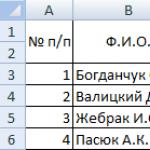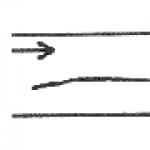Greater snail, or river sandpiper, or light-colored sandpiper - Tringa nebularia: description and images of the bird, its nest, eggs and voice recordings. Big ulit Big ulit
A representative of the snipe family, a rare species that requires protection and protection. This article will talk about the big snail in a detailed format.
Description, appearance
The snail is not too large in size, the weight of adult individuals ranges from 110 to 280 grams. The body shape is slightly elongated. The paws are dark green in color and quite long. The beak is upturned, the tip points upward. The wings, in comparison with the rest of the color, stand out. They are usually dark. From the head evenly and beautiful pattern small specks are distributed. The lower part of the body is white without any inclusions or peculiar patterns. Thanks to such an interesting color, the large snail cannot be confused with other birds. Young representatives are similar to adults, but there are some distinctive features. Their chest is off-white, with dark markings, streaks and stripes.
Spreading
In Europe, he prefers to settle in the northern regions, in countries such as Russia and Scotland. It winters in the warmest places, for example, in Africa, Spain, Italy, where several dozen representatives were regularly spotted. Individuals of this species are also found in the Caucasus, as in mountainous area, and in swamps. They especially like to spend cold times in the south. For them there is the most favorable and suitable climate. There are also all the opportunities for a quiet existence, including the necessary food supplies.They are very fond of various bodies of water and wetlands. They migrate in small groups, about 10 birds.
Nesting and breeding
Their nest is a hole in the ground, usually quite small size. The female lays 4 eggs and incubates them for 24 days. They build nests near any source of water, it can be a river, a pond, a swamp. There must also be a noticeable object nearby. They do this, guided by the instinct of self-preservation, which allows them to protect themselves from certain threats. The adult representatives are very caring and accompany the chicks until they fly. The babies' muscles are slowly strengthening and becoming stronger every day. But adult birds still show anxiety and restlessness.
Voice
Relatives

It is impossible not to talk about the so-called “relatives” of the big snail. This includes the morodunka. It also has an upturned beak and an interesting coloration. But her paws are dark yellow. He also likes to winter in Africa, Western Europe. But in Italy it is rarely seen - this is rather an exception. Morodunka is also spreading in Russia. As a comfortable place for its nests, it chooses warm areas near rivers and various reservoirs. A very similar behavior pattern to large waders; they show care for their offspring.
Number
The large snail is a worthy representative of its family. The bird has an unusual color, which makes it immediately noticeable. Unfortunately, a trend towards a reduction in this species has been noticed. The issue became very acute, and some measures were taken. After all, this greatly alarmed the specialists. The environment is deteriorating every year, many species of animals, birds, and plants are disappearing. Therefore, we must try to preserve nature and what it has given. Measures are required that help improve the situation and create a certain balance and harmony that reigned until a person began to destroy everything that prevented him from achieving his selfish goals. We have now begun to actively implement measures to protect environment, and it really helps.
Likewise, the number of large snail has increased over the past decade. The species has mastered new places where it now builds its nests and raises its offspring. For example, representatives of the family were spotted in the Moscow region.
Measures taken to see improvements
It is worth noting those measures that helped increase the numbers. Firstly, the species was listed in the Red Book. This made it possible to draw attention to such a problem as disappearance over a certain period of time. After all, every year the figure became smaller. Protected nests played an important role in the spread of the large snail in the Moscow region. The day before, recommendations were put forward on organizing protection sites for birds. They are under the protection of professionals, which will keep them safe. The snails found acceptable living conditions and a suitable climate. Now you can be sure that everything will be fine, and perhaps the species will “grow” and spread to other areas.
Video: Great snail (Tringa nebularia)
Class: Birds Order: Charadriiformes Family: Snipe Genus: Snails Species: Large snail
Great Snail - Tringa nebularia
Appearance.
Almost the size of a pigeon. The beak is slightly curved upward, the legs are dark, long, and in flight protrude far beyond the end of the tail. The top is brown-gray, the chest is streaked, the underparts and rump are white, and the underwings are striped. In winter the upperparts are brownish-gray.Lifestyle.
Inhabitant of the forest zone, in some places it enters the forest-tundra; on migration it is found along the muddy coasts of seas, rivers and lakes. Migrant. Common. Nests in forest lakes, rivers and moss swamps. The nest is a hole lined with blades of grass or moss, usually located near a hummock or stump. The clutch from mid-May to the end of June consists of 4 fawn eggs with sharp blackish-brown spots. The laying of the eggs is preceded by lekking flights, during which the male emits a very loud and beautiful whistling cry “tli-tui, tli-tui.” When a person approaches the nest, it flies around screaming and sits on the branches of trees, balancing on its wings. During non-breeding times, he is careful. It forages for food in the water, wading into it almost up to its belly. It feeds on insects and their larvae, often eating small fish and fry. It differs from the herbal snail and the goldfinch by its dark legs, from the Siberian ash snail by its dark upperparts (in addition, from all these waders, the great snail differs in its curved beak), from the Okhotsk snail by its striped underside of the wing.Reference books by geographer and traveler V.E. Flint, R.L. Boehme, Yu.V. Kostin, A.A. Kuznetsov. Birds of the USSR. Publishing house "Mysl" Moscow, edited by prof. G.P. Dementieva.
inexpensive(at production cost) buy(order by mail cash on delivery, i.e. without prepayment) our copyright teaching materials on zoology (invertebrate and vertebrate animals):
10
computer (electronic) determinants, including: insect pests of Russian forests, freshwater and migratory fish, amphibians (amphibians), reptiles (reptiles), birds, their nests, eggs and voices, and mammals (animals) and traces of their vital activity,
20
colored laminated definition tables, including: aquatic invertebrates, diurnal butterflies, fish, amphibians and reptiles, wintering birds, migratory birds, mammals and their tracks,
4
pocket field determinant, including: inhabitants of reservoirs, birds of the middle zone and animals and their traces, as well as
65
methodological benefits And 40
educational and methodological films By methods carrying out research work in nature (in the field).
Big snail, or river sandpiper, or light sandpiper(obsolete) - Tringa nebularia

Appearance.
Almost the size pigeon, the dark beak is slightly curved upward. The color is brownish-gray above, the undertail and rump are white, and there are dark streaks on the crop, sides, throat, back and shoulders. The legs are long, dark green, the wing is striped underneath.
Loud melodic two-syllable whistle “tli-tui”.
Habitat.
Lives in forest swamps.
Nesting sites.
Typical nesting sites for the large snail are areas of coastal meadows overgrown with grass and low bushes, moss swamps with small lakes and sparse pine trees, as well as extensive swampy clearings with isolated trees.
Nest location.
Nests on the ground. The nest is usually located in a dry area near a bush, between stones or near the trunk of a fallen tree.
Nest building material.
To line the tray he uses grass leaves and pine needles.
Shape and dimensions of the nest.
It is a shallow hole in moss or soil, sparsely lined with leaves of grass and pine needles.
Features of masonry.
The clutch contains 4 cone-shaped eggs. Their color is yellowish-brown, cream or yellowish-white. Towards the blunt end of the egg there are sharply defined large red-brown spots, as well as smaller markings and a small number of deeper grayish-blue spots. Egg size: (45-54) x (31-36) mm.
Nesting dates.
Arrives at nesting sites on different dates in April. Nests with eggs are found in May, downy chicks - at the end of May and June. Departure takes place in the second half of August - September.
Spreading.
Distributed throughout almost the entire taiga zone, in places in the forest-tundra and forest-steppe from Britain to Kamchatka. To the south it is distributed in the northwestern lake region, along the valleys of the Oka and Kama rivers, and in negligible quantities further south; in addition, it is found in the mountains of Central Asia.
Wintering. Winters partly in Britain and Transcaucasia, but mainly in Africa, South Asia, Australia and New Zealand.
Economic importance.
The meat of the great snipe is excellent compared to many other waders, not much inferior to the meat of the snipe. Due to its extreme caution, the ulita shoots mainly at evening feeding sites, lying in wait from an ambush.
Description of Buturlin.
Big ulit is truly the most big from snails. Its body is almost the same as that of a lapwing, although at first glance it seems smaller than the latter due to its shorter and much narrower wings.
From a distance a large street seems light, in autumn almost whitish or ashy, and in the summer the bright white color of not only the rump and loin, but the entire back of the back stands out sharply. Based on these characteristics, one of the waders in the southern half of our country, the sandpiper, is very similar to the large snail, but this latter one is one and a half times smaller. Julitta is easy to recognize by its ringing scream“kew-kew-kew...” or “whew-whew...”.
Plumage The upper side is brown, with blackish centers of feathers and smoky-brown wide edges, and on the head with white edges. The throat, crop, chest and sides are white, with brown markings; belly white. Underwing coverts and axillary feathers; with smoky transverse spots or stripes. Tail feathers, except for one or two lateral pairs, with brown transverse stripes. In autumn attire the mantle is grayer and lighter, the black color is reduced to core stripes; the underside is almost entirely white, with only dark streaks on the sides of the crop and chest. Juveniles have a brown mantle, with buffy and whitish marginal spots; craw feathers with narrow, smooth dark edges.
The eye is brown; the beak is brown, slightly curved upward, but not arched, but at a very obtuse angle; legs are olive or yellowish green. Wing length 15.5-20 centimeters. The plumage of the frenulum does not reach the posterior edge of the nostril by 1.5-2.5 millimeters.
In spring the first big snails are shown in the southern parts of our country around mid-April, singly, in pairs and in small flocks; at the beginning of May they appear already in the Leningrad region, and at the end of the middle ten days of May - even in lower Pechora, beyond 65° north latitude.
Having split into pairs, the waders arrange their nests mainly in forest swamps, each pair at some distance from the other. The nest is most often placed near a hummock, stone or fallen tree. Nests and eggs regular Easter cake type; the eggs range from 45.8 to 59.8 millimeters in length and 32.4-37.7 millimeters in width.
Young in the Northern region they take wing around July 20. In the first days they are very quiet, hide tightly in the grass and reluctantly fly out from under your feet. Their parents protect them even at this time. It happened to be observed that, noticing a person approaching such a brood three hundred steps away, the female, sitting on a dry top, warns the young with a frequent loud cry.
On our website you can read guide to ornithology: anatomy and morphology of birds , bird food , bird breeding , bird migration And variety of birds.
In the non-profit online store of the Ecosystem Ecological Center you can purchase following teaching materials on ornithology:
computer(electronic) bird identification guide for central Russia, containing descriptions and images of 212 bird species (bird drawings, silhouettes, nests, eggs and calls), as well as computer program identification of birds found in nature,
pocket reference guide "Birds of the middle zone",
"Field guide to birds" with descriptions and images (drawings) of 307 species of birds in central Russia,
colored definition tables"Birds of Passage" and "Wintering Birds", as well as
MP3 disc"Voices of birds of central Russia" (songs, cries, calls, alarm signals of the 343 most common species of central Russia, 4 hours 22 minutes) and
MP3 disc"Voices of birds of Russia, part 1: European part, Ural, Siberia" (B.N. Veprintsev's music library) (singing or mating sounds, calls, signals when disturbed and other sounds that are most important in the field identification of 450 bird species in Russia, duration playing time 7 hours 44 minutes)
Kulik-Selyanets (formerly - Ulіt Vyalyki)
Brest region - single registrations in the east
Vitebsk region - nesting
Gomel region - single registrations in the west
Minsk region - extreme north and extreme northeast
Mogilev region - west and center
Snipe family - Scolopacidae.
Monotypic species, does not form subspecies.
Rare breeding migratory species. Nesting has been proven by only a few finds in the Vitebsk region: 06/21/1975 a downy chick was caught in the Berezinsky Nature Reserve; 05/06/1987 a nest with a clutch of 4 fresh eggs was found in the Liozny district; On May 21, 1995, a nest with 4 fresh eggs was found in the Shumilinsky district; On May 18, 2002, another nest with 3 fresh eggs was found in the same place. One of the last finds of 4 pairs + chick occurred on May 26, 2013 in the Krasny Bor nature reserve, Rossonsky district. Also separate pairs of large snail with clear signs nesting behavior was recorded in spring and summer in raised bogs in other areas of the Vitebsk region. (Miory, Sharkovshchinsky, Vitebsk).
In addition, large snails with signs of nesting behavior were recorded in some swamp areas of the Mogilev, Gomel and Brest regions, but nesting here requires confirmation by finds of nests or flightless chicks. In the southern part of the republic in summer period recorded in the Olmansky swamps, where there is probably an isolated settlement, since the breeding of the species has been proven in the border regions of Ukraine.

Relatively large sandpiper. The color of the plumage is very similar to the porcupine, the main differences being its noticeably larger size and a slightly upturned beak. The upperparts are light brown with white streaks, especially on the front of the back. Its back and lower back are white. The underparts are also white, but there are black-brown longitudinal streaks on the crop and chest. The outer tail feathers are white, the middle pair is smoky gray with dark transverse stripes. The beak is of medium length, laterally compressed and noticeably bent upward. Its color is dark brown. Legs are brownish-green. Brown rainbow. Male weight 155-180 g, female 148-195 g. Body length (both sexes) 33-37 cm, wingspan 62-70 cm. Male wing length 18-19 cm, tail 7.5-8.5 cm, tarsus 6.5-7 cm, beak 5-6 cm. Wing length of females 18-19.5 cm, beak 4.5-6 cm, tarsus 6-6.5 cm.

Like other snails, they willingly perch on trees, especially on dry tops and branches. They do not form large flocks. Even during flights they stay in small groups. Very careful birds.
The large ulit lives mainly in forest swamps or swampy river floodplains adjacent to the forest, along the banks of forest lakes, among vast raised and transitional swamps, sparsely overgrown with swamp pine and shrubs. Sometimes it settles in open areas of floodplain meadows, overgrown with tall grass, shrubs and solitary trees.
A characteristic nesting bird of the raised swamps of the Belarusian Lake District. It is most numerous in the ridge-lake complex of vegetation and near large swamp lakes with rafting shores.

It is also found in the ridge-hollow complex with pine, giving preference to rafting areas.
It nests in separate pairs, choosing the most remote uninhabited areas. When nesting, the most secretive of the waders in Poozerie, as a rule, makes a nest in swamp pine forests, even in very closed wild rosemary on low manes and along the edges of islands, in groves along the shores of swamp lakes.
Most often, ulit was observed in flooded open areas. However, the first nest of the great snail, discovered on May 6, 1987, was located in a sphagnum pine forest along the edge of a small raised bog in the Liozno district of the Vitebsk region. The nest was located on a hummock, open, near several pine trees: one dry (3 m high) and two green (1.7 and 2.0 m high).

The nest is a hole trampled in a moss hummock, hidden among sedge, heather or wild rosemary, lined with dry blades of grass, pine needles, and moss.
The tray of the first nest found was abundantly lined with dry pine needles with a small admixture of small heather branches.
When examining one incomplete clutch of three eggs on May 18, 2002, there was no lining in the tray; in other nests with full clutches, the trays were lined with dry leaves of blueberry, bog myrtle, and thin flakes of pine bark. Also, pine needles were always present in the tray, since the nests were often located under the cover of swamp pines, often on moss hummocks near the trunk. One more interesting feature large snails is that they almost always make nests next to the dry trunks of fallen swamp pines.
Nest dimensions: tray diameter 9.3–14.0 cm, average 11.9±0.6 cm; tray depth 3.5–7.5 cm, average 5.3±0.5 cm.
 Vladimir Bondar. Zatoka "Tehnopribor", env. Mogilev
Vladimir Bondar. Zatoka "Tehnopribor", env. Mogilev
A full clutch contains 4 eggs, in exceptional cases 5. In Europe, isolated finds of clutches consisting of 7 or 8 eggs (belonging to more than one female) are known. In the examined complete clutches in Poozerie there were 3–4 eggs, on average 3.9±0.1 eggs per clutch. The eggs are pear-shaped. The shell is slightly shiny, sometimes matte. The color of its main background varies from light yellowish-brown or dark creamy to yellowish-gray. Large and small surface spots, sometimes larger strokes or relatively small specks and specks of a dark or black-brown or light red-brown color. They are distributed evenly or concentrated predominantly at the obtuse pole. The deeper spots are light gray, violet-gray and brownish-gray. Egg sizes: 32.7–42.4x46.7–55.0 mm, on average 34.7±0.3x49.9±0.3 mm. Egg weight is 25.70–32.56 g, on average 28.96 ± 0.37 g.

The bird begins nesting in early May, but fresh clutches can be found in the first ten days of this month. In friendly warm springs, fresh clutches in Poozerie were found from May 6 to 8, and in cold, protracted springs, an incomplete clutch of three eggs was examined on May 18 and a complete fresh clutch in another nest on May 21. Clutches of varying degrees of incubation were examined from May 9 to May 23. A newly dried chick was found on April 25, 2008, 23 m from the nest (in the nest itself there was a dead downy chick and egg shells). Chicks in downy plumage, but of different sizes, were seen from June 15 to June 21; a chick that began to fledge was observed on June 10, 2000.
There is one brood per year. The male and female incubate the clutch for 24-25 days; later, both birds lead the chicks and protect the brood in case of danger. Large snails incubate the eggs very tightly: they fly up 1.5–5 m from the researcher and sometimes move away, pretending to be a wounded bird.
Immediately after hatching, the large snail transfers the chicks to flooded open areas, where adult birds become very noticeable by their alarm cries heard from afar.

The autumn migration begins in mid-August and continues throughout September.
The food of the large snail is various invertebrates, primarily insects and their larvae (including aquatic ones), arachnids, and small mollusks.
Adult large snails are found in the prey of the golden eagle, and chicks are found in the prey of the merlin.
The number of large snail in those raised bogs of the Belarusian Lake District where it nests ranges from 1 pair per 10 km² (in swamps with an area of at least 1000 hectares) to 6 pairs per 10 km² (in smaller swamps). The drainage reclamation of raised bogs and, to a lesser extent, the disturbance factor have a significant impact on the number of large snails in the Belarusian Lake District.
Included in the Red Book of the Republic of Belarus.
The maximum age recorded in Europe is 24 years 5 months.
 Vladimir Bondar. Zatoka "Tehnopribor", env. Mogilev
Vladimir Bondar. Zatoka "Tehnopribor", env. Mogilev

Literature
1. Grichik V.V., Burko L.D. "Fauna of Belarus. Vertebrates: textbook" Minsk, 2013. -399 p.
2. Nikiforov M. E., Yaminsky B. V., Shklyarov L. P. “Birds of Belarus: A guide to nests and eggs” Minsk, 1989. -479 p.
3. Fedyushin A.V., Dolbik M.S. “Birds of Belarus”. Minsk, 1967. -521 p.
4. Ivanovsky V.V., Vorobiev V.N., Mindlin G.A. "Materials on the ecology of waders of the Belarusian Lake District" / Bulletin of the Vitsebsk State University. 2015. No. 1. P.38-43
5. Minutes of the meeting of the Belarusian Ornithological and Faunal Commission (BOFK) dated February 17, 2015.
6. Mongin E. A. “Big snail” / Red Book of the Republic of Belarus. Animals. Rare and endangered species of wild animals. Ed. 2nd.
Minsk, 2006. P.126-127
7. Kozlov V.P., Lychkovsky B.D. “On the nesting of the great snail in the Belarusian Poozerie” / Abstracts of the 12th Baltic Ornithological Conference.






